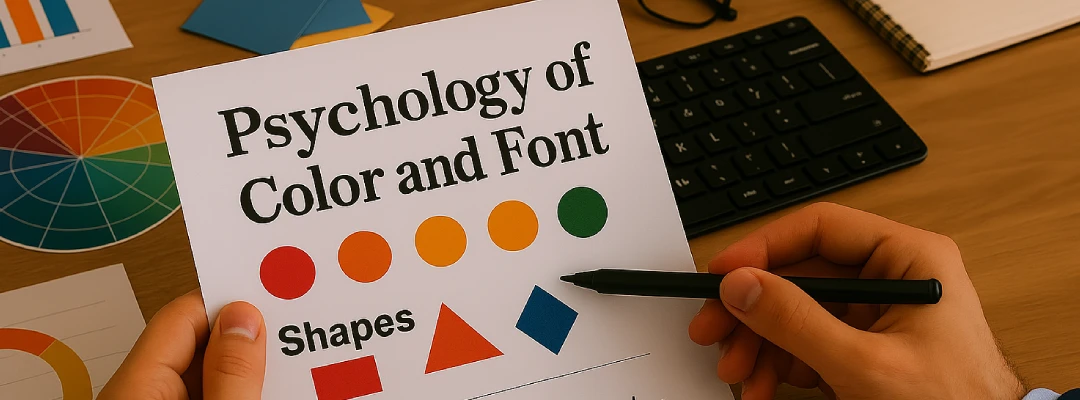Introduction
In the realm of advertising, the visual elements of a brand—colors, shapes, and fonts—play a pivotal role in shaping consumer perceptions and behaviors. These design components are not merely aesthetic choices; they are powerful tools that can evoke emotions, convey messages, and influence decisions. Understanding the design and psychology of color in advertising behind these elements is essential for creating effective marketing strategies that resonate with target audiences.
Why Understanding the Psychology of Color and Design is Important
The strategic use of colors, shapes, and fonts can significantly impact brand recognition and consumer trust. For instance, studies have shown that colors can boost brand recognition by up to 80% . Similarly, font choices can evoke specific feelings and associations, affecting how a brand is perceived . By comprehending these psychological underpinnings, brands can craft designs that not only attract attention but also foster positive consumer relationships.
The Influence of Colors on Consumer Perception
Psychology of color in advertising are deeply intertwined with human emotions and can trigger specific responses. For example:
- Blue is often associated with trust and security, making it a popular choice for financial institutions .
- Red evokes excitement and passion, commonly used in industries like food and entertainment to stimulate appetite and enthusiasm.
- Green symbolizes nature and health, frequently employed by brands that promote environmental friendliness or wellness.
Moreover, color preferences can vary based on cultural backgrounds and personal experiences, making it crucial for brands to consider their target demographics when selecting a color palette.
The Role of Shapes in Design Psychology
Shapes contribute significantly to the visual language of a brand:
- Circles and Ovals convey a sense of community, unity, and protection. They are often used by brands aiming to project inclusivity and friendship.
- Squares and Rectangles suggest stability, balance, and professionalism. These shapes are prevalent in corporate logos to communicate reliability.
- Triangles can represent direction, movement, or innovation, depending on their orientation. They are commonly used by brands that want to appear dynamic and forward-thinking.
The strategic use of shapes can reinforce brand messages and influence consumer trust and engagement.
Typography: The Subtle Art of Font Psychology
Fonts do more than display text; they carry emotional weight and can significantly impact brand perception:
- Serif Fonts (e.g., Times New Roman) are seen as traditional and reliable, often used by brands that wish to convey authority and respectability.
- Sans-Serif Fonts (e.g., Arial) are perceived as modern and clean, suitable for brands aiming for a contemporary and approachable image.
- Script Fonts evoke elegance and creativity, commonly used in industries like fashion and luxury goods.
Choosing the right typography ensures that the brand’s message aligns with its visual presentation, enhancing overall communication effectiveness.
Integrating Colors, Shapes, and Fonts for Maximum Impact
An integrated marketing strategy that harmoniously combines colors, shapes, and fonts can create a cohesive and compelling brand identity. For instance, an integrated marketing agency in Bangalore might employ a specific color scheme and typography across all platforms to ensure consistency and reinforce brand recognition. Similarly, marketing agencies in Mumbai may focus on culturally resonant shapes and colors to appeal to the local market.
Conclusion
The psychology of color and design is a critical component in crafting marketing materials that effectively communicate a brand’s message and values. By thoughtfully selecting colors, shapes, and fonts, businesses can influence consumer perceptions, evoke desired emotions, and drive engagement. An integrated marketing approach ensures that all visual elements work together seamlessly, creating a strong and memorable brand presence.
Does this interest you? Connect with us to see how we can help you!
Trending FAQs
- How do colors influence consumer behavior?
Psychology of color in advertising can evoke specific emotions and associations, impacting perceptions of a brand’s personality and influencing purchasing decisions. - Why is font choice important in branding?
Fonts convey subtle messages about a brand’s character; for example, serif fonts suggest tradition, while sans-serif fonts imply modernity. - Can shapes in a logo affect brand perception?
Yes, different shapes can symbolize various attributes like stability, innovation, or community, affecting how consumers perceive the brand. - How does cultural context influence color perception?
Cultural backgrounds can alter color associations; for instance, while white signifies purity in some cultures, it may represent mourning in others. - What is the role of typography in user experience?
Well-chosen typography enhances readability and user engagement, contributing to a positive overall experience with the brand. - How can an integrated marketing approach benefit brand design?
It ensures consistency across all marketing channels, reinforcing brand identity and making the brand more recognizable. - Are there industry-specific color preferences?
Yes, certain industries favor specific colors; for example, the tech industry often uses blue to convey trust and professionalism. - How do fonts impact readability and user engagement?
Clear and appropriate fonts improve readability, making content more accessible and engaging for users. - What is the significance of visual hierarchy in design?
Visual hierarchy guides the viewer’s attention to the most important elements first, improving the effectiveness of the communication. - How can businesses test the effectiveness of their design choices?
Businesses can use A/B testing, gather user feedback, and analyze engagement metrics to assess and refine their design strategies.




